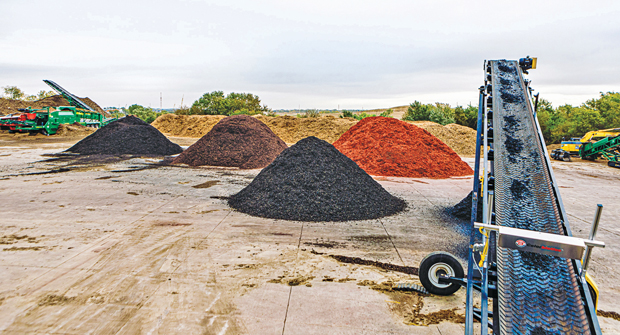As a landscape professional, you’re more than likely familiar with mulch and its core benefits for a landscape. But could there be more going on under the surface when you put mulch down on a property?
Experts from Colorbiotics and North Carolina State University share the underlying environmental benefits that mulch offers landscape contractors and the soil they manage.
Basics of mulch
On the surface, mulch acts as a barrier, blocking light and reducing weed germination. It also moderates soil temperature, keeping it cooler in summer and warmer in winter. This temperature regulation helps save water and protects roots from extreme conditions.
Mulch also helps water retention, saving your customers on irrigation and watering bills.
“There’s just as much benefit from the spaces between those pieces of mulch,” says Bill Fonteno, professor emeritus at North Carolina State University. “With the pore space, you exchange oxygen and carbon dioxide for the soil. That helps to keep the critters that are in there. Plus, you get water infiltration benefits because it helps slow down water loss from the surface.”
Soil benefits
But beyond these surface-level benefits, mulch can significantly improve your soil’s health without having to put in any extra effort.
“You can take (mulch), spread it out about three to four inches deep and not touch it,” says Fonteno. “If you pull that back after a while, you’ll see an inch or two of actual topsoil formed all by itself, and it’s done that because of the breakdown of these materials in the mulch.
“The more it breaks down, the better off you are, the better off the plants will be and the better action you’ll get in the soil itself.”
According to Fonteno, mulch’s effects on soil are even more precious in urban settings. So-called “urban soil” can vary from property to property, Fonteno says, depending on what the site used to be.
For example, a new home built on what used to be farmland will have better soil than a home in a more urban environment. Mulch can help even that playing field, according to Fonteno.
“You have to construct and build things with all kinds of organic matter to replenish that soil,” he says. “It takes diligence in putting mulch down because as it breaks down, it actually begins to feed the soil as well.
“The worse your soil is to begin with, the longer it’s going to take. But the more you plant in the same area and use these organics, the better off you’re going to be.”
Colorant considerations
Kent Rotert, vice president of Colorbiotics, a colorant manufacturer that offers more than a dozen colors of mulch for landscape purposes, says one of the more traditional uses of mulch is to add color to a plant bed.
“I think from a colorant side, the biggest factor is the beautification,” he says. “I think what’s critical for us in the manufacturing process is making a product that looks really good in addition to being safe for people and the environment.”
Finding a producer
When it comes to finding the right mulch producer, Rotert says that landscape contractors should keep several things in mind, from the material used to create the mulch to how they purchase the mulch (i.e., in a bag or in bulk).
“I always recommend looking for producers that are part of the Mulch and Soil (Council),” says Rotert. “Look for that seal on the back of that bag that shows that they’re a Mulch and Soil certified member. That probably will give you the best choice of products in the marketplace today. Without that seal, it’s harder to find people that are qualified and using good practices in their manufacturing process.”


